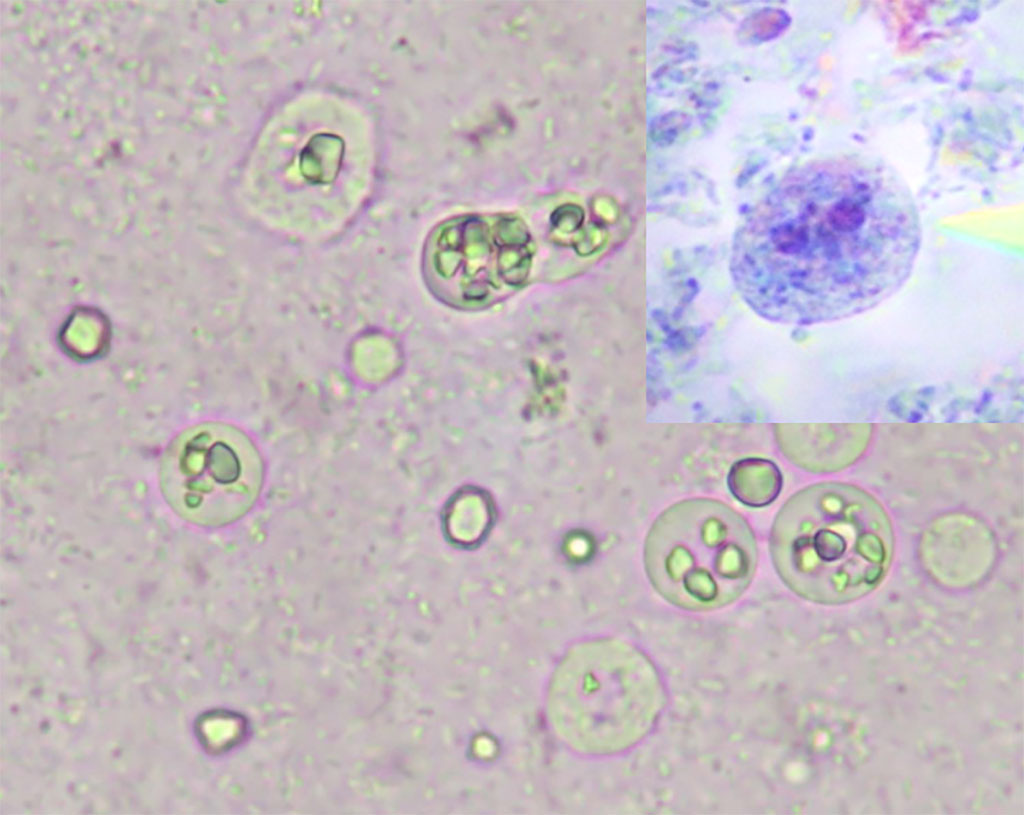Neglected Protists Found in Immunocompetent and Immunodeficient Diarrheal Patients
By LabMedica International staff writers
Posted on 04 Nov 2021
Diarrhea is one of the most widespread gastrointestinal symptoms and is a common problem in immunosuppressed patients. The spectrum of pathogens that cause diarrhea in immunosuppressed patients is significantly different from those in patients with a normal immune system.Posted on 04 Nov 2021
Blastocystis sp. and Dientamoeba fragilis are single-cell parasites of the human intestine which are common worldwide and reported in cases with gastrointestinal symptoms. However, the role of Blastocystis sp. and D. fragilis in patients with gastrointestinal symptoms is still controversial because their presence is not always associated with symptoms.

Image: Dientamoeba fragilis trophozoites in culture. Note that D. fragilis trophozoites ingested rice starch while Blastocystis spp., did not. Confirmation with microscopic examination of trichrome-stained smears are required (Inset) (Photo courtesy of Manisa Celal Bayar University School of Medicine)
Medical Microbiologists at the Gazi University (Ankara, Turkey) collected individual stool samples from 438 outpatients between March 2017 and December 2019. Diarrhea was defined according to the Bristol Stool Form Scale. Stool samples were examined macroscopically and compared to the Bristol stool chart, and stools consistent with type 6 (fluffy pieces with ragged edges, a mushy stool) and type 7 (watery, no solid pieces, entirely liquid) were considered diarrhea.
All collected stool samples were independently screened for the presence of enteric parasites by conventional (Native-Lugol examination, FECT, trichrome, and acid-fast staining) and molecular methods for the detection of Blastocystis sp. and D. fragilis. Blastocystis sp. and D. fragilis positive stool samples were screened by ELISA test for Entamoeba histolytica, Giardia duodenalis and Cryptosporidium spp. (TECHLAB, Blacksburg, VA, USA). All stool samples were tested by quantitative polymerase chain reaction (qPCR) for both Blastocystis sp. and D. fragilis every two weeks. Amplification reaction was carried out in a Rotor-Gene 6000 real-time cycler (Rotor-Gene Q, Germantown, MD, USA).
The scientists reported that the prevalence of Blastocystis sp. and D. fragilis was 16.7% and 11.9%, respectively as measured by qPCR. The prevalence of Blastocystis sp. and D. fragilis was lower in immunodeficient patients (12.7% and 10.6%, respectively) compared to immunocompetent patients (21.8% and 13.5%, respectively). The common occurrence of co-infection of these two parasites may indicate that there are shared sources of transmission. Five Blastocystis sp. subtypes were identified and the following subtype distribution was observed: ST3 54.4% (n = 37), ST2 16.2% (n = 11), ST1 4.4% (n = 3), ST6 2.9% (n = 2), ST4 1.5% (n = 1), ST2/ST3 11.8% (n = 8) and ST1/ST3 8.8% (n = 6). There was no statistically significant difference in the distribution of Blastocystis sp. subtypes between immunocompetent and immunodeficient patients. Low infection rates were found for G. duodenalis and Cryptosporidium spp. in this study (<1%). The authors concluded that their findings demonstrated that Blastocystis sp. and D. fragilis are commonly present in immunocompetent and immunodeficient patients with diarrhea. This study is the first to use next generation sequencing to address the presence of Blastocystis sp. mixed subtypes and intra-subtype variability in clinical samples in Turkey. The study was published on October 6, 2021 in the journal PLOS Neglected Tropical Diseases.
Related Links:
Gazi University
TECHLAB
Rotor-Gene Q













